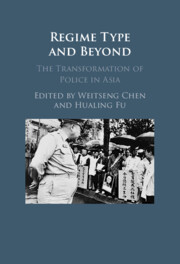Book contents
- Regime Type and Beyond
- Regime Type and Beyond
- Copyright page
- Contents
- Figures
- Tables
- Contributors
- Abbreviations
- Part I Framework
- 1 Mapping the Authoritarian and Democratic Divide
- 2 Discipline or Democracy
- Part II Authoritarian Policing: Past and Present
- Part III Democratic Transition and Authoritarian Resilience
- Part IV The Singapore and Hong Kong Exceptions
- Part V Conclusions
- Index
1 - Mapping the Authoritarian and Democratic Divide
The Transformation of Policing in Asia
from Part I - Framework
Published online by Cambridge University Press: 25 May 2023
- Regime Type and Beyond
- Regime Type and Beyond
- Copyright page
- Contents
- Figures
- Tables
- Contributors
- Abbreviations
- Part I Framework
- 1 Mapping the Authoritarian and Democratic Divide
- 2 Discipline or Democracy
- Part II Authoritarian Policing: Past and Present
- Part III Democratic Transition and Authoritarian Resilience
- Part IV The Singapore and Hong Kong Exceptions
- Part V Conclusions
- Index
Summary
This edited volume explores the nature of authoritarian policing, its transformation and resilience, and its rule of law implications. The discussion of the evolution of policing takes place in the context of the overall development of the police, their professionalization, institutional autonomy and neutrality, legality, and their credibility within the communities they manage and serve. What makes policing “democratic” is a contested concept and the definition varies depending on the level of abstraction and the particular focus of the inquiry. While regime type, which is itself a contested concept, the close nexus between the coercive power of the police and the state, it is never dispositive. Thus, the dichotomous categorization of authoritarian policing (AP) and democratic policing (DP), while useful as a starting point for comparative analysis, misses a large amount of nuance and often overlooks the plurality of either system, neglecting the fact that a police system can be authoritarian or democratic in multiple ways and in different aspects of policing. This volume rejects this simple binary view. It aims to untie and unpack the nexus between the police and the political system and to explore the plurality of both AP and DP.
Keywords
- Type
- Chapter
- Information
- Regime Type and BeyondThe Transformation of Police in Asia, pp. 3 - 25Publisher: Cambridge University PressPrint publication year: 2023



